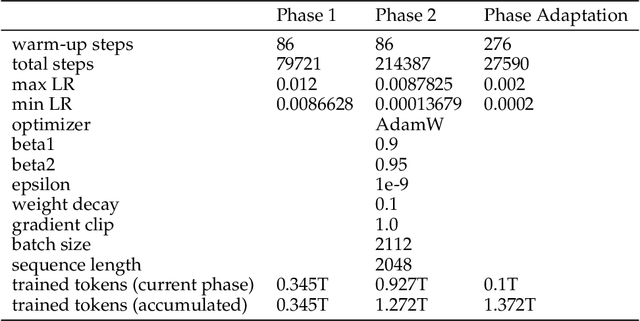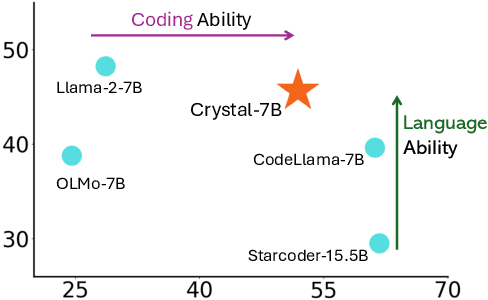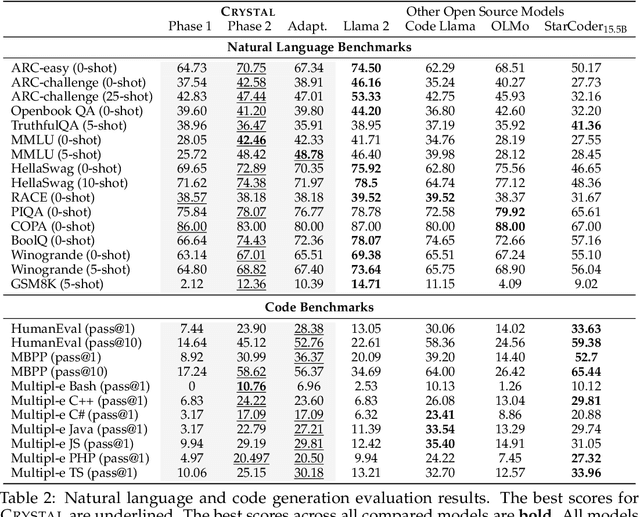Zhengzhong Liu
Token Level Routing Inference System for Edge Devices
Apr 10, 2025Abstract:The computational complexity of large language model (LLM) inference significantly constrains their deployment efficiency on edge devices. In contrast, small language models offer faster decoding and lower resource consumption but often suffer from degraded response quality and heightened susceptibility to hallucinations. To address this trade-off, collaborative decoding, in which a large model assists in generating critical tokens, has emerged as a promising solution. This paradigm leverages the strengths of both model types by enabling high-quality inference through selective intervention of the large model, while maintaining the speed and efficiency of the smaller model. In this work, we present a novel collaborative decoding inference system that allows small models to perform on-device inference while selectively consulting a cloud-based large model for critical token generation. Remarkably, the system achieves a 60% performance gain on CommonsenseQA using only a 0.5B model on an M1 MacBook, with under 7% of tokens generation uploaded to the large model in the cloud.
MegaMath: Pushing the Limits of Open Math Corpora
Apr 03, 2025Abstract:Mathematical reasoning is a cornerstone of human intelligence and a key benchmark for advanced capabilities in large language models (LLMs). However, the research community still lacks an open, large-scale, high-quality corpus tailored to the demands of math-centric LLM pre-training. We present MegaMath, an open dataset curated from diverse, math-focused sources through following practices: (1) Revisiting web data: We re-extracted mathematical documents from Common Crawl with math-oriented HTML optimizations, fasttext-based filtering and deduplication, all for acquiring higher-quality data on the Internet. (2) Recalling Math-related code data: We identified high quality math-related code from large code training corpus, Stack-V2, further enhancing data diversity. (3) Exploring Synthetic data: We synthesized QA-style text, math-related code, and interleaved text-code blocks from web data or code data. By integrating these strategies and validating their effectiveness through extensive ablations, MegaMath delivers 371B tokens with the largest quantity and top quality among existing open math pre-training datasets.
CITER: Collaborative Inference for Efficient Large Language Model Decoding with Token-Level Routing
Feb 04, 2025Abstract:Large language models have achieved remarkable success in various tasks but suffer from high computational costs during inference, limiting their deployment in resource-constrained applications. To address this issue, we propose a novel CITER (\textbf{C}ollaborative \textbf{I}nference with \textbf{T}oken-l\textbf{E}vel \textbf{R}outing) framework that enables efficient collaboration between small and large language models (SLMs & LLMs) through a token-level routing strategy. Specifically, CITER routes non-critical tokens to an SLM for efficiency and routes critical tokens to an LLM for generalization quality. We formulate router training as a policy optimization, where the router receives rewards based on both the quality of predictions and the inference costs of generation. This allows the router to learn to predict token-level routing scores and make routing decisions based on both the current token and the future impact of its decisions. To further accelerate the reward evaluation process, we introduce a shortcut which significantly reduces the costs of the reward estimation and improving the practicality of our approach. Extensive experiments on five benchmark datasets demonstrate that CITER reduces the inference costs while preserving high-quality generation, offering a promising solution for real-time and resource-constrained applications.
LLM360 K2: Building a 65B 360-Open-Source Large Language Model from Scratch
Jan 16, 2025Abstract:We detail the training of the LLM360 K2-65B model, scaling up our 360-degree OPEN SOURCE approach to the largest and most powerful models under project LLM360. While open-source LLMs continue to advance, the answer to "How are the largest LLMs trained?" remains unclear within the community. The implementation details for such high-capacity models are often protected due to business considerations associated with their high cost. This lack of transparency prevents LLM researchers from leveraging valuable insights from prior experience, e.g., "What are the best practices for addressing loss spikes?" The LLM360 K2 project addresses this gap by providing full transparency and access to resources accumulated during the training of LLMs at the largest scale. This report highlights key elements of the K2 project, including our first model, K2 DIAMOND, a 65 billion-parameter LLM that surpasses LLaMA-65B and rivals LLaMA2-70B, while requiring fewer FLOPs and tokens. We detail the implementation steps and present a longitudinal analysis of K2 DIAMOND's capabilities throughout its training process. We also outline ongoing projects such as TXT360, setting the stage for future models in the series. By offering previously unavailable resources, the K2 project also resonates with the 360-degree OPEN SOURCE principles of transparency, reproducibility, and accessibility, which we believe are vital in the era of resource-intensive AI research.
Libra-Leaderboard: Towards Responsible AI through a Balanced Leaderboard of Safety and Capability
Dec 24, 2024



Abstract:To address this gap, we introduce Libra-Leaderboard, a comprehensive framework designed to rank LLMs through a balanced evaluation of performance and safety. Combining a dynamic leaderboard with an interactive LLM arena, Libra-Leaderboard encourages the joint optimization of capability and safety. Unlike traditional approaches that average performance and safety metrics, Libra-Leaderboard uses a distance-to-optimal-score method to calculate the overall rankings. This approach incentivizes models to achieve a balance rather than excelling in one dimension at the expense of some other ones. In the first release, Libra-Leaderboard evaluates 26 mainstream LLMs from 14 leading organizations, identifying critical safety challenges even in state-of-the-art models.
Crystal: Illuminating LLM Abilities on Language and Code
Nov 06, 2024



Abstract:Large Language Models (LLMs) specializing in code generation (which are also often referred to as code LLMs), e.g., StarCoder and Code Llama, play increasingly critical roles in various software development scenarios. It is also crucial for code LLMs to possess both code generation and natural language abilities for many specific applications, such as code snippet retrieval using natural language or code explanations. The intricate interaction between acquiring language and coding skills complicates the development of strong code LLMs. Furthermore, there is a lack of thorough prior studies on the LLM pretraining strategy that mixes code and natural language. In this work, we propose a pretraining strategy to enhance the integration of natural language and coding capabilities within a single LLM. Specifically, it includes two phases of training with appropriately adjusted code/language ratios. The resulting model, Crystal, demonstrates remarkable capabilities in both domains. Specifically, it has natural language and coding performance comparable to that of Llama 2 and Code Llama, respectively. Crystal exhibits better data efficiency, using 1.4 trillion tokens compared to the more than 2 trillion tokens used by Llama 2 and Code Llama. We verify our pretraining strategy by analyzing the training process and observe consistent improvements in most benchmarks. We also adopted a typical application adaptation phase with a code-centric data mixture, only to find that it did not lead to enhanced performance or training efficiency, underlining the importance of a carefully designed data recipe. To foster research within the community, we commit to open-sourcing every detail of the pretraining, including our training datasets, code, loggings and 136 checkpoints throughout the training.
Web2Code: A Large-scale Webpage-to-Code Dataset and Evaluation Framework for Multimodal LLMs
Jun 28, 2024



Abstract:Multimodal large language models (MLLMs) have shown impressive success across modalities such as image, video, and audio in a variety of understanding and generation tasks. However, current MLLMs are surprisingly poor at understanding webpage screenshots and generating their corresponding HTML code. To address this problem, we propose Web2Code, a benchmark consisting of a new large-scale webpage-to-code dataset for instruction tuning and an evaluation framework for the webpage understanding and HTML code translation abilities of MLLMs. For dataset construction, we leverage pretrained LLMs to enhance existing webpage-to-code datasets as well as generate a diverse pool of new webpages rendered into images. Specifically, the inputs are webpage images and instructions, while the responses are the webpage's HTML code. We further include diverse natural language QA pairs about the webpage content in the responses to enable a more comprehensive understanding of the web content. To evaluate model performance in these tasks, we develop an evaluation framework for testing MLLMs' abilities in webpage understanding and web-to-code generation. Extensive experiments show that our proposed dataset is beneficial not only to our proposed tasks but also in the general visual domain, while previous datasets result in worse performance. We hope our work will contribute to the development of general MLLMs suitable for web-based content generation and task automation. Our data and code will be available at https://github.com/MBZUAI-LLM/web2code.
Pandora: Towards General World Model with Natural Language Actions and Video States
Jun 12, 2024



Abstract:World models simulate future states of the world in response to different actions. They facilitate interactive content creation and provides a foundation for grounded, long-horizon reasoning. Current foundation models do not fully meet the capabilities of general world models: large language models (LLMs) are constrained by their reliance on language modality and their limited understanding of the physical world, while video models lack interactive action control over the world simulations. This paper makes a step towards building a general world model by introducing Pandora, a hybrid autoregressive-diffusion model that simulates world states by generating videos and allows real-time control with free-text actions. Pandora achieves domain generality, video consistency, and controllability through large-scale pretraining and instruction tuning. Crucially, Pandora bypasses the cost of training-from-scratch by integrating a pretrained LLM (7B) and a pretrained video model, requiring only additional lightweight finetuning. We illustrate extensive outputs by Pandora across diverse domains (indoor/outdoor, natural/urban, human/robot, 2D/3D, etc.). The results indicate great potential of building stronger general world models with larger-scale training.
LLM360: Towards Fully Transparent Open-Source LLMs
Dec 11, 2023



Abstract:The recent surge in open-source Large Language Models (LLMs), such as LLaMA, Falcon, and Mistral, provides diverse options for AI practitioners and researchers. However, most LLMs have only released partial artifacts, such as the final model weights or inference code, and technical reports increasingly limit their scope to high-level design choices and surface statistics. These choices hinder progress in the field by degrading transparency into the training of LLMs and forcing teams to rediscover many details in the training process. We present LLM360, an initiative to fully open-source LLMs, which advocates for all training code and data, model checkpoints, and intermediate results to be made available to the community. The goal of LLM360 is to support open and collaborative AI research by making the end-to-end LLM training process transparent and reproducible by everyone. As a first step of LLM360, we release two 7B parameter LLMs pre-trained from scratch, Amber and CrystalCoder, including their training code, data, intermediate checkpoints, and analyses (at https://www.llm360.ai). We are committed to continually pushing the boundaries of LLMs through this open-source effort. More large-scale and stronger models are underway and will be released in the future.
SegMix: A Simple Structure-Aware Data Augmentation Method
Nov 16, 2023Abstract:Interpolation-based Data Augmentation (DA) methods (Mixup) linearly interpolate the inputs and labels of two or more training examples. Mixup has more recently been adapted to the field of Natural Language Processing (NLP), mainly for sequence labeling tasks. However, such a simple adoption yields mixed or unstable improvements over the baseline models. We argue that the direct-adoption methods do not account for structures in NLP tasks. To this end, we propose SegMix, a collection of interpolation-based DA algorithms that can adapt to task-specific structures. SegMix poses fewer constraints on data structures, is robust to various hyperparameter settings, applies to more task settings, and adds little computational overhead. In the algorithm's core, we apply interpolation methods on task-specific meaningful segments, in contrast to applying them on sequences as in prior work. We find SegMix to be a flexible framework that combines rule-based DA methods with interpolation-based methods, creating interesting mixtures of DA techniques. We show that SegMix consistently improves performance over strong baseline models in Named Entity Recognition (NER) and Relation Extraction (RE) tasks, especially under data-scarce settings. Furthermore, this method is easy to implement and adds negligible training overhead.
 Add to Chrome
Add to Chrome Add to Firefox
Add to Firefox Add to Edge
Add to Edge